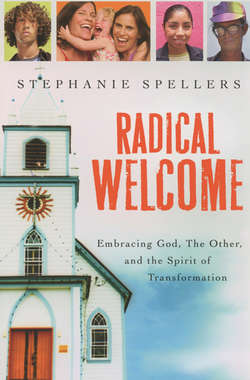Читать книгу Radical Welcome - Stephanie Spellers - Страница 16
На сайте Литреса книга снята с продажи.
Radical Welcome Is . . .
ОглавлениеHow do all those elements finally come together at the congregational level? When I describe a church as “radically welcoming,” it means the community seeks to welcome the voices, presence and power of many groups—especially those who have been defined as The Other, pushed to the margins, cast out, silenced, and closeted—in order to help shape the congregation’s common life and mission.
Few communities could achieve the vision of radical welcome in its totality. Radically welcoming communities are the ones committed to transformed life, a life that aims to be:
• Hospitable: They seek to offer a gracious, warm space to all people, especially those who have been defined as “Other,” systemically disempowered and oppressed, pushed to the margins. In the Episcopal Church and most mainline churches, that could include people of color, poor people, children and young adults, gay and lesbian people, seniors, people with disabilities, and many other groups.
• Connected: They link to their neighbors, to their neighborhood, to brothers and sisters beyond their neighborhood with whom they actively practice what it means to embrace and be changed by Jesus.
• Centered: They possess a clear, compelling sense of Christian identity. That self-understanding is based in part in their cultural and denominational heritage, but primarily in the unapologetic and clear call to live out the dream of God as they have discerned it in light of Scripture, tradition, reason, and their context.
• Open to conversion: They attempt to listen carefully to, make room for, share power with, and learn from groups who’ve been silenced, closeted and disempowered, and they are open to genuine conversion and transformation based on this encounter with The Other. On the ground, that means they allow God’s Spirit and the gifts of The Other to enrich and transform their understanding of who is inside and who is outside, what ministries they undertake, how they select leaders, how they do business, how they worship, what they claim as their mission and purpose, and how they partner with other groups.
• Intentional: They engage in training, research, active listening, strategic planning: some conscious, contextually appropriate effort that addresses individual, congregational, institutional, and systemic change. They realize radical welcome does not come merely as a matter of goodwill or a by-product of enthusiastic outreach programs.
• Comprehensive: They recognize that the work cannot be left to a specialized ministry area, like the Outreach Ministry, the Social Justice Team or the Hospitality Committee; it is a way of being, and should eventually be cultivated by the chief leaders through formation, worship, mission, and other areas of congregational life.
• Becoming: They realize this journey is never finished, so they are always becoming, always looking beyond the congregation to see who has been left out or pushed out, always aware that the stranger’s face is the very face of Christ.
• Beyond diversity: They understand that radical welcome is not merely about diversity, evangelism, multiculturalism, inclusion, or getting it “right.” It is simply, profoundly about being faithful disciples of the Christ who welcomed and still welcomes all.
• Faithful: They honor radical transformation not as a necessary evil or as change for the sake of change, a response to misplaced liberal guilt or a church growth strategy, but instead because they are saying “yes” to God’s gracious invitation to welcome as Christ welcomes.
• Compassionate: They prioritize the work of creating “space for grace”9: small groups, forums and other settings where people can develop, express and hold their dreams and their fear of change, even as they deepen their commitment to radical welcome.
• Real: They acknowledge they will not be perfect or consistently, radically embrace every group. A radically welcoming congregation is one where the members are becoming God’s radically welcoming people.
